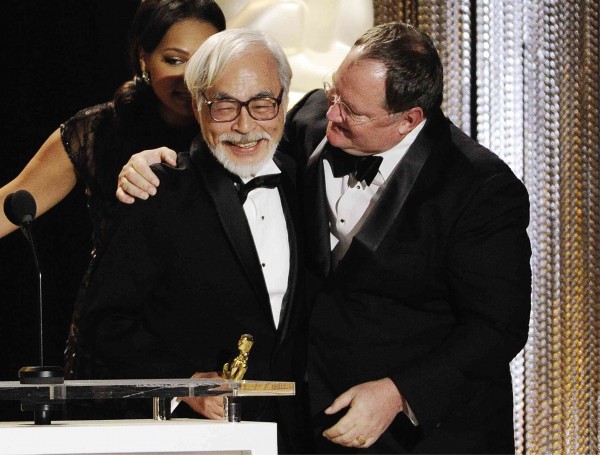
JAPANESE animator Hayao Miyazaki (left) received his trophy from longtime fan John Lasseter at the 2014 Governors Awards. AP
One of the highlights of last year’s 27th Tokyo International Film Festival was a special hour-long audience with filmmaker John Lasseter, the same animation wiz behind Pixar and the hit franchise flicks “Toy Story” and “Cars,” held at the EX Theater Roppongi.
Lasseter was invited to speak at the fest because an animated film that he executive-produced, “Big Hero 6,” was chosen by organizers as the opening film.
Lasseter’s audio-visual presentation, which consisted of clips from old movies and similarly dusty photos from his personal collection, quickly turned into a master class on animation and, at the same time, an affectionate love letter to Japan.
While preparing for his talk, Lasseter owned up, “I realized what a huge influence Japan had [on my life and career].”
Like any baby boomer, he grew up watching Saturday morning cartoons, he recalled. He was not aware then, but among his favorite animated programs at that time, “Astro Boy” and “Speed Racer,” were Japanese imports.
Cherished dream
The teenager who did a book report on Bob Thomas’ “Walt Disney: The Art of Animation” later fulfilled a cherished dream and was hired by Disney studios.
He eventually became the chief creative officer of Pixar, Walt Disney Animation Studios and Disney Toon Studios. But we’re getting ahead of the story.
Back in 1977, the young animator watched “Star Wars,” “waiting in line for six hours,” like other fans.
It was akin to witnessing “a revolution in cinema,” he looked back.
“It had a profound effect on me. I wanted to do…what ‘Star Wars’ did to film…to animation,” he confessed.
In Hollywood, animation was widely regarded as kid stuff. Lasseter, however, had other ideas.
In 1981, he was introduced by Japanese animation producer Yutaka Fujioka of TMS Studio to the work of Hayao Miyazaki—specifically, “Lupin III: The Castle of Cagliostro.”
“I was blown away,” he remarked. “It was an animated film created with the vision to entertain people of all ages. It made me feel that I was not alone in the world.”
He showed an excerpt, a car-chase sequence, from “Lupin III,” which he described as “smart, clean…the greatest action scene ever put on film.”
It was a technical feat, he said. “Part of the scene is animated background, part of it is sliding painted background. It was exciting.”
He later admitted that he “wooed” wife Nancy with “Lupin III.”
Immersion
A 1987 trip to Japan was another turning point. He recounted that he traveled to Tokyo for a lecture at Nicograph (a computer animation conference), but ended up immersing himself in the country’s colorful culture.
His snapshots from that trip were stored in a box labeled by his wife, thus: “The trip to Japan when John took way too many photos.”
He went crazy for the bright neon lights of Ginza, the curious vending machines on every street corner that sell everything from whiskey to instant noodles, plastic sushi displayed in restaurant shop windows, Tomy wind-up tin toys and, of course, the Bullet Train.
His memories of Tokyo eventually ended up in two films—one he directed (“Cars 2”) and another one he produced (“Big Hero 6”).
On that first trip, he made sure to visit Studio Ghibli and his idol Miyazaki and he commemorated the encounter with a souvenir photo. “That was almost three decades ago,” Lasseter said as his photo with Miyazaki was shown onscreen.
Miyazaki gave Lasseter a tour of the studio and showed drawings from the film the Japanese animator was working on then, “My Neighbor Totoro.”
In this year’s Busan International Film Festival, to be held in South Korea from Oct. 1 to 10, “My Neighbor Totoro” will be shown in the Open Cinema section.
“He puts his heart and soul in every film,” Lasseter said of Miyazaki. “It was my inspiration in making films.”
He would often visit Miyazaki-san, as the American filmmaker calls his idol, every time he was in Tokyo.
When Lasseter later showed Miyazaki his 1995 film “Toy Story,” he was initially apprehensive. “I was told he wasn’t a big fan of computer animation…but he saw past the medium and loved the story.”
Lasseter became Miyazaki’s staunchest supporter—helping promote his sensei’s films in the West and the rest of the film-loving world.
He showed another Miyazaki clip, from “My Neighbor Totoro,” and lauded its keen attention to detail, the distinct characterization of the two sisters and the awesome cat bus.
(The English version of “Totoro” features Filipino singer-actress Lea Salonga, who lent her voice as the mom of the kids voiced by Dakota and Elle Fanning.)
Slew of awards
Lasseter related: “I helped in doing the English version of ‘Spirited Away.’ I consulted Hayao about something…his response was: ‘If people want to understand my films, they will have to learn Nippongo.’”
“Spirited Away” later won a slew of awards, including the Golden Bear at the Berlin Film Fest in 2002 and the Oscar for best animated film in 2003.
In November, Lasseter served as presenter when Miyazaki was given an honorary award by the Academy of Motion Picture Arts and Sciences at the 2014 Governors Awards.

